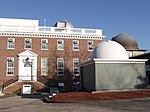Buckingham Browne & Nichols School

Buckingham Browne & Nichols School, often referred to as BB&N, is an independent co-educational day school in Cambridge, Massachusetts, educating students from pre-kindergarten (called Beginners) through twelfth grade. BB&N is regularly ranked among the top independent schools in the United States. The School has produced three of the 27 Presidential Scholars from Massachusetts since the inception of the program in 1964 and is a member of the G30 Schools group and the Round Square global education association. BB&N includes six Rhodes Scholars among its graduates. The School occupies four campuses: a Lower School on Buckingham Street, a Middle School on Sparks Street, an Upper School on Gerry's Landing Road, and an office building on Belmont Street. In 2017 the school consisted of 1017 students, 146 faculty, and 148 administrators and staff. BB&N was founded in 1974 from the merger of two schools, Browne & Nichols School and the Buckingham School. Prior to the merger, Browne & Nichols was a boys school consisting of grades 7-12; Buckingham School enrolled students in grades K-12: boys and girls in grades K-6 and girls only in grades 7-12. Federal judge Nathaniel M. Gorton is the former chair of the school's board of trustees.
Excerpt from the Wikipedia article Buckingham Browne & Nichols School (License: CC BY-SA 3.0, Authors, Images).Buckingham Browne & Nichols School
Buckingham Place, Cambridge
Geographical coordinates (GPS) Address Nearby Places Show on map
Geographical coordinates (GPS)
| Latitude | Longitude |
|---|---|
| N 42.3791 ° | E -71.1296 ° |
Address
Buckingham Browne & Nichols School (Lower School Campus)
Buckingham Place
02163 Cambridge
Massachusetts, United States
Open on Google Maps










